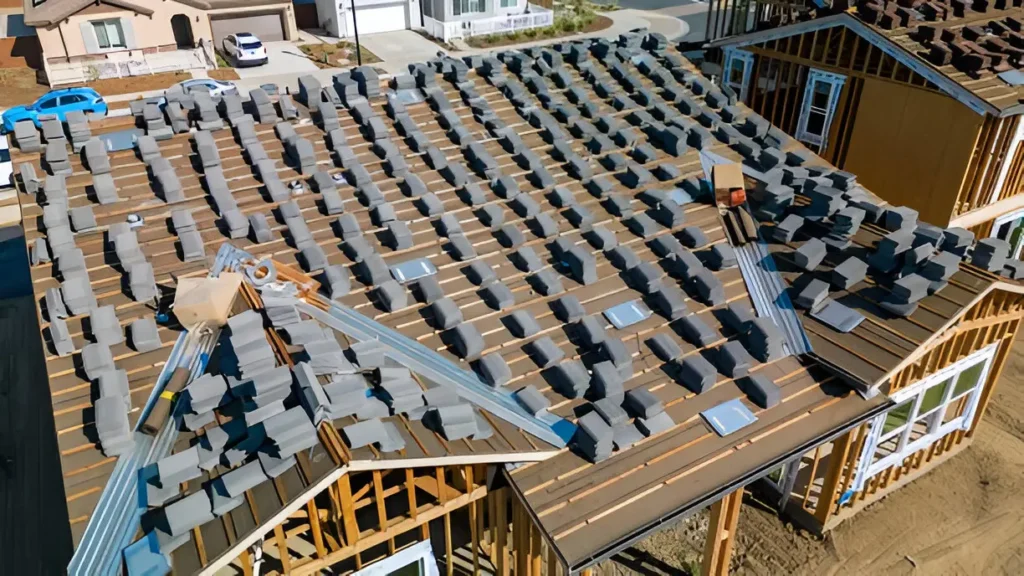The roofing materials industry stands as one of construction’s most resilient sectors, with the U.S. market alone valued between $23.35 billion to $44.39 billion in 2024, depending on measurement methodology. This essential industry continues to demonstrate remarkable growth despite economic fluctuations, driven by aging infrastructure, extreme weather events, and technological innovation that’s reshaping how Americans protect their homes and businesses.
A Market in Transformation
The roofing materials sector is experiencing unprecedented change. Climate-related disasters, including hurricanes, hailstorms, and wildfires, have fundamentally altered consumer priorities, pushing demand toward durable, impact-resistant, and fire-retardant solutions. The Department of Energy’s Weatherization Assistance Program, allocating $3.5 billion for energy efficiency upgrades in low-income homes, exemplifies how government initiatives are accelerating market transformation.
Market projections vary significantly based on scope, with conservative estimates showing growth from $23.35 billion in 2024 to $44.24 billion by 2034 at a 6.60% CAGR. Other analyses project the market reaching $68.64 billion by 2032, reflecting different methodologies and inclusion criteria. What remains consistent across all projections is the upward trajectory, driven by both replacement cycles and new construction demand.
Material Innovation Driving Competition
Asphalt shingles continue to dominate the market, comprising over 55% of all roofing materials by volume. Their affordability and proven performance maintain their position as the go-to choice for residential applications, which represent approximately 58% of total market revenue. However, metal roofing is gaining significant ground, particularly in fire-prone regions where Class A fire ratings provide crucial protection.
The emergence of integrated solar roofing systems represents a paradigm shift in material functionality. GAF Energy’s Timberline Solar ES 2, launched in February 2025, delivers 23% more power than its predecessor while maintaining the aesthetic appeal of traditional shingles. This convergence of energy generation and weather protection exemplifies how manufacturers are redefining product categories to meet evolving consumer demands.
Regional Dynamics and Supply Chain Evolution
The Northeast region leads U.S. roofing demand with a 31% market share, driven by aging housing stock and exposure to harsh weather conditions. This regional concentration has prompted strategic positioning by suppliers and manufacturers. In the greater Los Angeles area, established distributors like LA Roofing Materials have leveraged their four-decade presence to maintain stable inventory levels despite global supply chain disruptions. Their longstanding relationships with multiple manufacturers and deep understanding of California’s unique climate challenges have proven invaluable in ensuring contractors have consistent access to essential materials when national supply chains face pressure.
California’s influence extends beyond its market size. The state’s Title 24 energy standards, mandating cool roofs on certain structures, have created ripple effects throughout the industry. Manufacturers nationwide are adapting product lines to meet these stringent requirements, recognizing that California’s regulations often preview national trends.
Consolidation and Strategic Positioning
The industry is witnessing significant consolidation as companies position for long-term growth. QXO’s $11 billion acquisition of Beacon Roofing Supply in April 2025 created the largest publicly traded distributor of roofing materials in the United States. This trend toward consolidation reflects the industry’s evolution from a fragmented market of local suppliers to an increasingly sophisticated distribution network capable of managing complex supply chains and meeting diverse regional requirements.
GAF Materials Corporation, as the world’s largest roofing and waterproofing company, exemplifies the benefits of scale. Their June 2025 groundbreaking for a world-class shingle manufacturing facility in Newton, Kansas, demonstrates how industry leaders are investing in domestic production capacity to reduce supply chain vulnerabilities and meet growing demand.
Technology and Sustainability Convergence
Digital transformation is revolutionizing both product development and distribution models. Drone technology and AI-powered inspection systems are reducing assessment times by 50-70% while increasing accuracy. Companies like EagleView and DroneDeploy offer thermal imaging and 3D mapping services that identify structural issues before they become critical failures.
Sustainability initiatives are no longer optional add-ons but core business strategies. CertainTeed’s collaboration with the Insurance Institute for Business & Home Safety to develop FORTIFIED Roof program-compliant systems reflects how manufacturers are aligning product development with insurance industry requirements and climate resilience standards.
Economic Factors and Market Outlook
The U.S. Census Bureau reported 1,397,000 new private housing units authorized by building permits as of June 2025, indicating robust construction activity that directly translates to roofing material demand. Additionally, the residential renovation sector continues to drive significant volume, with roof replacements typically occurring every 15-20 years creating predictable demand cycles.
Labor shortages and rising installation costs present ongoing challenges. The skilled labor deficit has accelerated interest in prefabricated roofing components and factory-assembled solutions, particularly beneficial in post-disaster rebuilding zones where speed and consistency are critical.
Raw material costs remain volatile, with petroleum-based products essential for asphalt shingles subject to global market fluctuations. This volatility has prompted manufacturers to explore alternative materials and diversify supply sources, while distributors maintain larger inventory buffers to ensure project continuity.
Future Industry Direction
The roofing materials industry stands at an inflection point where traditional functionality meets advanced technology and sustainability requirements. Companies successfully navigating this transition are those investing in research and development, building resilient supply chains, and maintaining strong relationships with both manufacturers and end-users.
Federal initiatives supporting infrastructure modernization and climate adaptation will continue driving demand for advanced roofing solutions. The Infrastructure Investment and Jobs Act’s support for community resilience and housing modernization creates a favorable environment for continued industry growth.
As extreme weather events become more frequent and building codes more stringent, the roofing materials industry’s role in protecting America’s built environment becomes increasingly critical. Companies that successfully balance innovation with reliability, sustainability with affordability, and global sourcing with local service will define the industry’s next chapter in this essential sector of the American economy.
Also Read-The Business of Roofing Materials: Inside America’s Multi-Billion Dollar Industry



